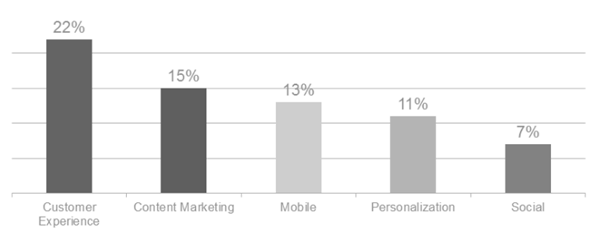*Source: https://www.statista.com/statistics/266488/forecast-of-mobile-app-downloads/
As per the Digital Marketing Trends for 2017, the apps are ranked according to the customer’s experience. Gather user feedback is the best method in understanding what the customer wants and improve that in the app.
Cost Effective
The app’s costing is not only done on the basis of its technicality but also the time duration and development resources. For instance, one bug could sometimes take days to fix or adding a new feature which would take months to roll out. Now imagine if you invest in all of these resources that the new feature doesn’t really matter to the end users? Isn’t that a waste of time! To ensure that you don’t face such a situation, it’s essential that you get some feedback from the customers before you plan to implement it. If you implement the feedback given by the users, then your company will yield apps that meet customer expectations.
Creating Correct Milestones
Create a feedback mechanism where the customers can voice their concerns and opinions, to understand which app features should be kept, which ones don’t really matter and which new ones should be created for the users. Making a roadmap for your app is very essential.
Understand Your Customers
Communication should always be a two-way communication. The only way an app developer can communicate with its end user or audience is by creating in app surveys that they can fill. Here, the customer can state their woes and issues that they face in the app. They can also rate certain services as being excellent, which as an app developer gives you the understanding of what your customer needs at the end of the day.
The idea is to ask the customer feedback in real time i.e., at the time when the user is facing a difficulty and can’t overcome it. A simple toolbar can be integrated for smooth and seamless feedback about the overall experience of the user.
Combining Analytics and Feedback
Customer feedback can also be deduced by analytics to a certain extent. But if customer feedback is combined with analytics, the app developer will have a clear idea of the issues that are caused. A problem can be pin-pointed with the help of analytics, for the instance, short sessions of users on the app. But do we know why the users are logging out of the app or using the app for a longer time? Here, the role of customer feedback comes in – you have got a lot of feedback about too many ads popping out or the session being timed out or the app hanging up on clicking a certain key or option.
When you have a thorough analysis of the data and the feedback from customers rectifying problems becomes relatively easier than trying to figure it out yourself. This in turn directly affects the number of user base on your app.
Conclusion
You need to work with CX-centric developers to integrate in app surveys and customer communication tools in the app. These tools can be found on the internet easily, but they aren’t incorporated in mobiles. Incorporating the tools gives you access to a wealth of knowledge given by the customers about the features and enhancements that can make your app more popular.
For instance, when a feedback tool in real time was incorporate in the app Urbanspoon, they received more than 7000 pieces of feedback. The Urbanspoon app worked on the feedback to make it better and a smoother experience for their customers with each new update.
Customer feedback shouldn’t be taken lightly or given to an intern. It is one of the key components to keep your business thriving and make your app popular. Feedback from customers is the only way to understand if your product or service is yielding benefits. In the end, you want to create a useful and rewarding experience for your customers can help your app attain success in the future.





